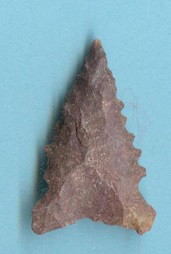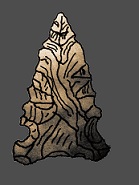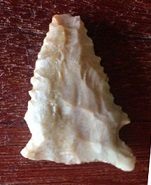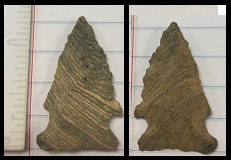Other Websites with Detailed Information:
Name Details:
Named By: James L. Mitchie
Named For: Type Site
Date Identified: 1966
Type Site: Taylor Site, central South Carolina
Taylor Side Notch
AKA: Spinners
Cluster:
Commonly Utilized Material:
Cherts, quarts, and quartzite
Date:
Cultural Period:
9,900 - 8,500 B.P.
Early Archaic
Early Holocene
Glacial Period:
Culture:
Outline is Representative of Size and Shape:
Description of Physical Characteristics and Flaking Pattern:
This is a medium triangular
side notch point with an elliptical cross section. The blade varies from excurvate to straight. The blade is commonly
serrated or beveled and may have a "twisted" appearance. Parallel notches are usually round to U-shaped with some examples having notches at a slight diagonal angle. The shoulders range from horizontal to having an upward angle. The stem is expanding with a concave
base. The basal edge may vary from rounded to square. Grinding is present on the hafting region. This point has a random flaking pattern.
Size Measurements: Total Length - 25 to
63 mm (average 39 to 43 mm), Stem Length -8 to 15 mm (average 9 to
10 mm), Blade Width - 15 to 30
mm (average 18 to 22 mm), Neck Width - 12 to 25 mm (average 13
to 15 mm), Stem Width - 15 to 31 mm, (average 19 to 24 mm -Slightly wider than the blade),
Thickness - 6 to 10 mm
Distribution:
Distribution Comments:
This point is primarily found in the Piedmont and into the foothills of the Appalachians of North Carolina and into north central Georgia and southern Virginia.
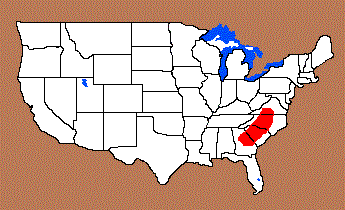
Related / Associated Points:
Additional Comments:
This is not the same point as the Taylor point named by Ripley Bullen which is a Woodland point found in Florida and into Georgia and Alabama.
Whatley (2002) feels that this is the same point as the Big Sandy point
identified by Kneberg.
Due to the twisted appearance of the blade, many collectors refer to these
points as Spinners. Other points in this Cluster:
Point Validity: Valid Type
Michie was an anthropologist and
a professor at Coastal Carolina University. He served as the associate director at the Waccamaw Center for Historical and Cultural Studies. He named this type in a professional publication. This type has limited professional references. This is considered a
valid type.
.
Age Details:
Sassaman (1995) reports places the Taylor Side
notch as the initial early Archaic period, dating from 9,900 to 9,500 B.P.
References: (See Reference Page, Entry Number):
23, 30, 57, 162, W18
Taylor Side Notch Projectile Point, Taylor Side Notch Arrowhead
